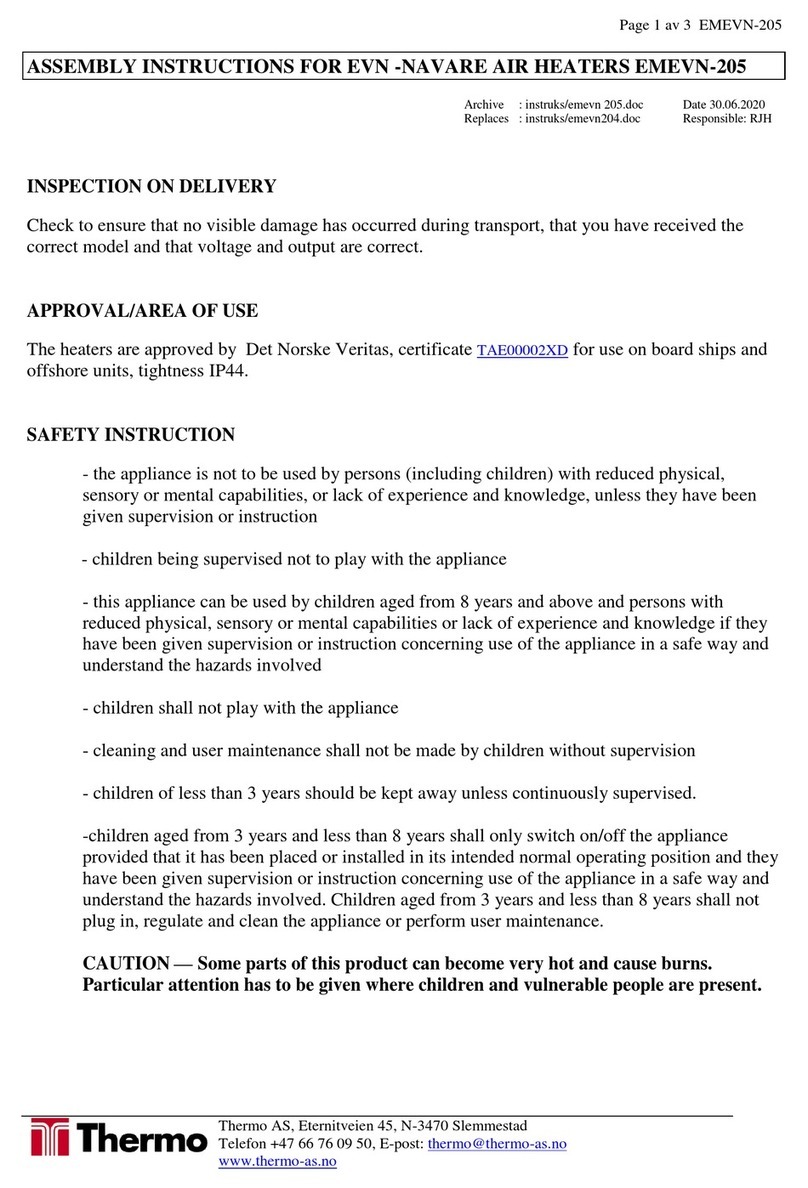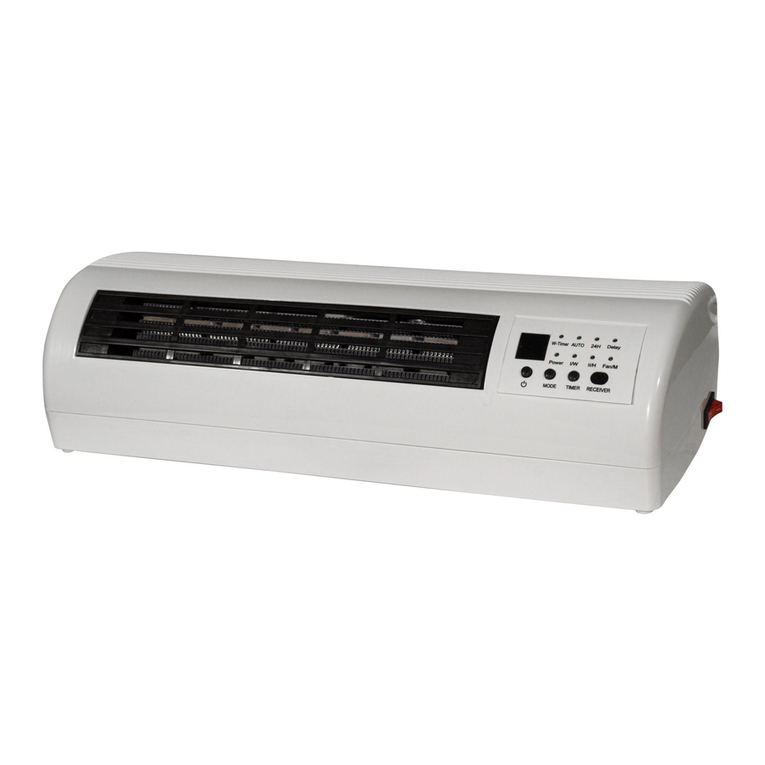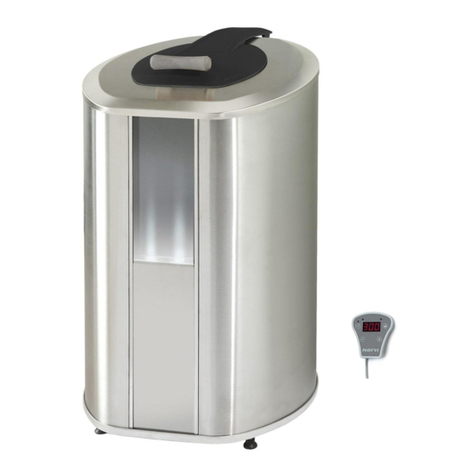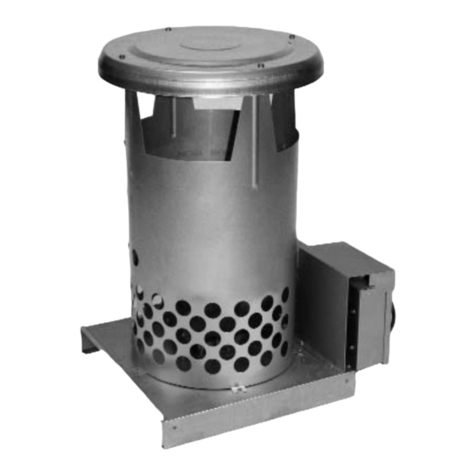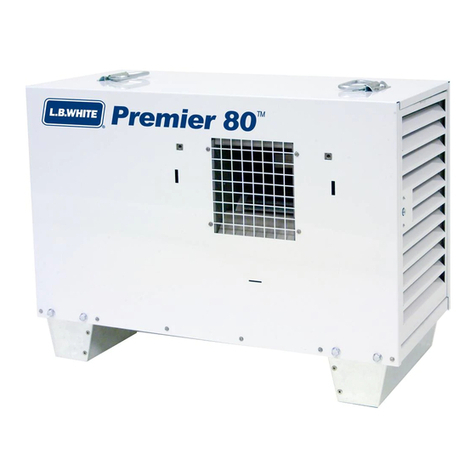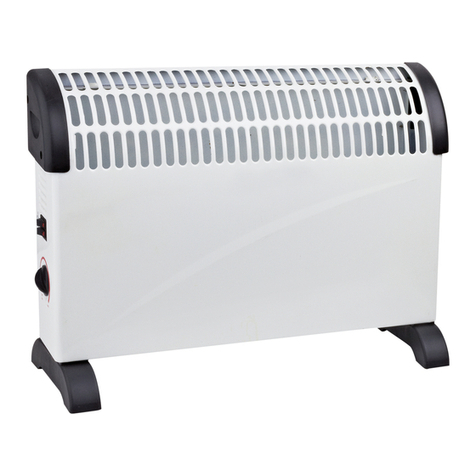Thermo HA24-50EB User manual

GARAGE HEATER WITH REMOTE CONTROL
INSTRUCTION MANUAL
MODEL: HA24-50EB
PET OWNERS WARNING: The health of some small pets,
including birds, are extremely sensitive to the fumes produced during the initial use of
many appliances. These fumes are not harmful to humans but we recommend that
you do not use your heater around birds and small pets during its initial use until the
manufacturing anti-corrosion coatings burn off.
Technical Support: 1-866-206-0888
Figure 1

TABLE OF CONTENTS
Important Instructions……………………………………3
Description and Specifications………………………….4
General Safety Information…………......................... ….5
Locating heater……………………………………………..6
Installation………………………………………………..7-11
Connecting the power…………………………………11-14
Operating Instructions…………………………………15-16
Maintenance Instructions…………………………………16

IMPORTANT INSTRUCTIONS
When using electrical appliances, basic precautions should always be followed toreduce
the risk of fire, electric shock, and injury to persons, including the following:
1. Read all instructions before installing or using this heater.
2. This heater is hot when in use. To avoid burns, do not let bare skin touch hot surfaces.
Keep combustible materials, such as furniture, pillows, bedding, papers, clothes and
curtains at least 3 feet (0.9 m) from the front of the heater and keep them away from the
sides and rear.
3. Extreme caution is necessary when any heater is used by or near children or invalids,
and whenever the heater is left operating and unattended.
4. Always turn off the power when not in use.
5. Do not operate any heater after it malfunctions, has been dropped or damaged in any
manner. Disconnect power at service paneland have heater inspected by a reputable
electrician before reusing.
6. Do not use outdoors.
7. This heater is not intended for use in bathrooms, laundry areas and similar indoor
locations. Never locate heater where it may fall into a bathtub or other water container.
8. To disconnect heater, turn controls to off, and turn off power to heater circuit at main
electrical panel.
9. Do not insert or allow any foreign objects to enter any ventilation or exhaust openings as
this may cause an electric shock, fire, or damage to the heater.
10. To prevent a possible fire, do not block air intakes or exhaust in any manner. Do not use
on soft surfaces, like a bed, where openings may be blocked.
11. A heater has hot and arcing or sparking parts inside. Do not use it in areas where
gasoline, paint, or flammable liquids are used or stored.
12. All wiring must be carried out by a certified electrician and comply with national and local
electrical codes in the United States andCanada
13. Use this heater only as described in this manual. Any other use not recommendedby the
manufacturer may cause fire, electric shock, or personal injury.
14. This heater may include a visual alarm to warn that parts of the heater are getting
excessively hot. If the alarm illuminates, immediately turn the heater off and inspect for
any objects on or adjacent to the heater that may have blocked the airflow or otherwise
cause high temperatures. DO NOT OPERATE THE HEATER WITH THE ALARM
ILLUMINATING.
15. This appliance is not intended for use by persons (including children) with reduced
physical, sensory or mental capabilities, or lack of experience and knowledge, unless
they have been given supervision or instruction concerning use of the appliance by a
person responsible for their safety. Children should be supervised to ensure that they
do not play with the appliance.
SAVE THESE INSTRUCTIONS

DESCRIPTION
Electric utility heaters are designed to meet a variety of heating requirements by switching a few
wires located in the base of the unit. Features horizontal and vertical air flow, built-in thermostat
and overheating safety thermal cut-out.
SPECIFICATIONS
Model Rating Voltage AMPS BTU/hour
HA24-50EB 5000W 240V 20.9
17,065
HEATER
RATING&VOLTAGE
HEATER
AMPS
FUSE
SIZE
MIN.WIRE SIZE
60°C COPPER
5000W@240V 20.9 30 #10
Circuit diagram Figure 2
Warning: This appliance must be grounded!
Warning: The appliance must be connected to a current protection circuit or
device with 30 Amp before being connected to power supply!
power light
Motor
caution light
AC240V/60Hz
External temperature control wiring
temperature sensor
T1
T2
T1

:
GENERAL SAFETY INFORMATION
: This heater requires hardwire installation (no plug).The installation of this
product must be carried out by a certifiedelectrician in accordance with all applicable local
and national electricalcodes.
NOTE: Compatible with a 240V line voltage single polewall thermostat. This thermostat
must be installed by a certifiedelectrician.
Read and understand all installation andoperation
instructions prior to operating this unit. Observe all safetyinstructions.
1.
Use only copper wires rated for at least 60ºC.
2.
Heater air flow must be directed parallel to or away from adjacent wall.
3.
Observe wall, floor and ceiling clearance requirements.
4.
All wiring must be done according to applicable national and local electrical codes in the
United States and Canada. The heater must be grounded as a precaution against possible
electrical shock. Heater circuit must be protected with proper fuses.
5.
The mounting and anchoring hardware must be capable ofreliably supporting the
weight of the heater and its mounting bracket.
6.
All electrical power must be disconnected and the main service box must belocked
before inspecting cleaning or servicing the hater. This precaution must be followed to
prevent serious electric shock.
7.
This heater is not suitable for use in hazardous locations as defined by thenational fire
protection association (NFPA) in the United States. This heater has hotand arcing
sparking parts inside. Do not use it in areas where gasoline paintor flammable liquids
are used or stored.
8.
This heater is not suitable for use in corrosive atmospheres such asmarine
greenhouses or chemical storage areas.
9.
This heater must be mounted at least 8 feet (2.44 m) above the floor.
Improper installation or failure to follow the procedures outlined inthis
instruction manual can result in serious electricalshock.

LOCATING HEATER
Install heater out of traffic areas, maintaining clearances stated in figure 3. The directionof air
flow should not be restricted is by columns or machinery and the air flow shouldwipe exposed
walls rather than blowing directly on them. When more than one heater is usedin an area, the
heaters should be arranged so that the air discharge of each heatersupports the air flow of the
others to provide best circulation of warm air as indicated in figure4.
Figure 4
Figure 3

3 ’’
3
’’
INSTALLATION
Hardware needed
You will also need the following hardware, which can be purchased from your local hardware
store or electrical supply store:
Electric wire in the adequate gauge and length for your application
Proper size fuse or breaker for your heater’s amperage
Proper wire connectors for your application
Fasteners appropriate for your application that are strong enough to hold the unit
MOUNTING THE HEATER ON THE CEILING
Refer to Figures 5a and 5b.
1. Locate a wood stud in the wood ceiling joist. If you cannot locate a wood stud, you have to
install a wood piece on the ceiling as this heater must be securely fastened.
2. Remove the mounting bracket from the heating unit by loosening bracket screws witha
wrench and slipping the handle off over the screw heads.
3. Place a washer on screws before inserting through the holes in the mounting bracket and
screw them securely into a ceiling joist.
NOTE: If you want to swivel the heater either to the right or left adding a washer to both
sides of the bracket is recommended. A longer lag bolt may be required to properly secure
the unit. See Figure 5a.
WASHER
WASHER
BRACKET
BRACKET
8
DIAGONAL
LAG BOLT
Figure 5a-single-Screw Mounting
/
8
DIAGONAL
LAG BOLT
Figure 5b-Double-Screw
Mounting
HANGING THE HEATER
1) Lift the heater up and into the mounting bracket.
2) Align the bracket screws with the keyhole slots in the mounting bracket.
3) If the heater is to be tilted it must be positioned in the keyhole slots - see figure 6.
4) Tighten the bracket screws with a wrench so the unit is securely suspended at
horizontal or vertical level.
Wood Ceiling
Wood Ceiling

USE BOTTOM KEYHOLE
SLOTS IF HEATER IS TO
BE TILTED
DOWN
Figure 6
ADJUSTING AIR FLOW DIRECTION
1. To turn the unit when it has been installed with a single lag bolt (as shown in
figure 5a), simply turn the entire heater as needed(as shown in figure 7).
The unit cannot be turned horizontally if it has been installed with 2 lag bolts.
2. To tilt the unit vertically, loosen the bracket screws (see figure 6).
3. Adjust louvers to the desired position.
NOTE: To prevent possible overheating, please maintain adequate clearance as
shown in figure 3.
Figure 7
NOTE: The louvers are designed so they cannot be completely closed. Do not
attempt to defeat this feature; damage to the unit can result.
MULTIPLE VERTICAL ANGLES
Keyholes
Bracket Screws
REMOVE SCREWTO
COVER

Figure 8
MOUNTING THE HEATER ON THE WALL’S WOOD STUD ONLY
Refer to Figures 9A to 9E.
1. Slide the support plate into the tripod; align both square holes and tighten with screws.
(Figure 9A)
2. Install the tripod on the wall with two screws. (Figure 9B)
3. Attach the bracket on the heater, making sure it is securely fastened. (Figure 9C)
4. Place the heater (with its bracket) on the support plate. The heater can be tilted at 3
different angles. Use two screws to secure the unit in the desired angle. (Figure 9D)
5. Adjust the horizontal angle (Figure 9E)

Wall Hanging Installation (wood stud only)
Attach with screw (M4*12*1)
Support plate
WALL
2. Install the bracket on
the wall with two screws
(ST10*30*2)
Tripod
1. Slide the support plate
into the tripod
Figure 9A Figure 9B
3. Use the keyholes to
lock different angles
Figure 9C
4. Attach the heater
to the brackets with
washer & screw
(M10*20*1)
Figure 9D
5. The heater can be fixed at 3 different angles. Use two screws (M6*16*2) to
secure the unit in each angle.

Figure 9E
NOTE: The louvers are designed so they cannot be completely closed. Do not attempt to
defeat this feature; damage to the unit can result.
CONNECTING THE POWER
External thermostat wiring diagram
NOTE: If you will use an external temperature control (external thermostat) with this heater,
please follow instructions below:
NOTE: Turn off the power to the supply line for the heater before you select the
build-in / external thermostat.
power light
Motor
caution light
AC240V/60Hz
External temperature control wiring
temperature sensor
T1
T2
T1

1. Please find the rocker switch on the back of the heater as shown below and shift the switch
to“ II”position to allowthe heater to be controlled by an external thermostat.
Figure 10
2. The external thermostat should comply with UL or ETL standard requirements.
3. The lead wire of the external thermostat must have a minimum gauge of 16 AWG.
External thermostat installation
1.
Open the holes on the side
2. Remove both screws
Figure 11A Figure 11B
3. Strip away the wire cover by 50mm
4. Twist the wire through the end
5. Bend it into a circle
From the external control box.
I II
Build in Thermostat External thermostat
(External temperature
control)
Figure 11C Figure 11D Figure 11E

Figure 11F Figure 11G
8.
Tighten the screws with a screwdriver
Figure 11H
7. Connect the wires to the appliance and
secure them
6. Pass in the wires through the hole

CONNECTION OF POWER CABLES
1. Remove the screw from the front of the unit to connect the power to the heater.
2. Attach the cable connectors to the unit (See Figure 12) and slide the 8-gauge wire through the
cable connector.
3. Connect the wire to the power block located in the base of the heater - See Figure13.
4. Turn on the power at the main electrical panel.
NOTE: All wiring must be carried out by a certified electrician and must bein accordance to
applicable national and local electrical codes. For certain applications, conduit may be required.
Check local electrical codes.If
you run the wiring in conduit and wish to be able to turn the
heater be sureto purchase enough flexible conduits to allow the heater to beturned.
Figure 12
Figure 13

OPERATING INSTRUCTIONS
Note: After setting an external thermostat to control the heater, the power selection &
timer switch on the remote will be the only working function on the heater itself.
Control Panel
Power indicator (amber)
Timer
button
Press these buttons to set the desired
room temperature
Caution indicator
(RED)
LED
display Fahrenheit Temp/ Celsius Temp
Figure 14
R e m o te c o n tro l
Use buttons on remote control
in the
same way as the buttons on
the
heater
’
s
control panel.
Figure 15
Once the room temperature reaches the set point, the heater will automatically
stop running.
After each operation for 5 seconds, the LED displays the current
Tim
meer
Pow
weerr
!
Power
Timer
room temperature.

Instructions in Normal mode (temperature controlled by built-in thermostat)
* Power button
You can use the power button as the Power switch.
The power button is also used to change the heating output between low & high (L/H);
the LED will display “L” or “H” accordingly
Model HA24-50EB: Low (L) →3000W; High (H) →5000W
.
*Temperature selection
Press the “F/℃” button to change the temperature displayed between Fahrenheit and
Celsius.
Press the “+” or “-” button to set the desired temperature between 5 ℃ and 35 ℃.
Hold down the “+” or “-” button to speed up the selection process.
.
*Timer selection
Use the “Timer” button to set the operating time of your heater, from 1 hour to 24 hours.
With each press of the “Timer” button, the timer will increase by 1 hour on the LED screen.
TO PROTECT THE HEATING ELEMENT
The heater includes a fan delay function to prevent risk of overheating.
When turning the heater off, the unit will close the heating element first and then the fan will continue
working for 90 seconds to dissipate residual heat.
THERMAL CUT-OUT
The heater will automatically turn off when parts of it overheat. When this happens, the red indicator
will turn on. The heater will turn ON again and the red indicator will turn off when the unit cools down
back to normal levels, but the reason of the overheating must be determined and corrective action
taken before further operation.
THE HEATER MUST STOP WORKING
WHEN THE CAUTION INDICATOR IS GLOWING RED.
NOTE: When the thermal cut-out is activated, the caution indicator will turn red. In this case,
immediately turn the heater OFF and inspect for any objects on or adjacent to the heater that may
cause high temperatures. Let heater cool off completely before turning on again.
MAINTENANCE INSTRUCTIONS
1.
Before cleaning, make sure the power has been turned off at the circuit breaker panel and the
heating element of the heater is completely cool.
2. To maintain the appearance of the heater, it need only be wiped over occasionally with a dry
duster. During the summer months, or at other times when the appliance is not in use and is
completely cold, it can be 0cleaned by wiping it with a damp cloth. Do not let water drip
inside the heater.
3. Do not use abrasive clearing powders or furniture polish to clean this appliance. Do not
use chemical or abrasive products, metallic scourers and similar items; they may
deteriorate the surface.
4.
All servicing should be performed by qualified service personnel. Do not try to repair the
heater yourself.
Table of contents
Other Thermo Heater manuals
Popular Heater manuals by other brands

UNITED
UNITED MICA UHM-782 user manual

Dimplex
Dimplex RFV-800 Installation & operation manual

Amba
Amba Traditional T-2536 installation instructions

Thermon
Thermon Norseman XB Series Installation, operation & maintenance instructions
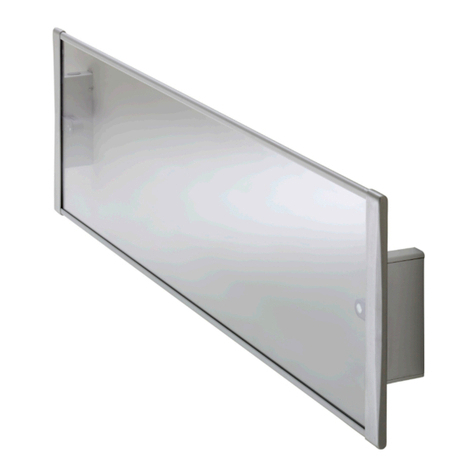
NOBOCOOL
NOBOCOOL G3 Series installation instructions

Dimplex
Dimplex WFE 3TNB Installation and operating instructions
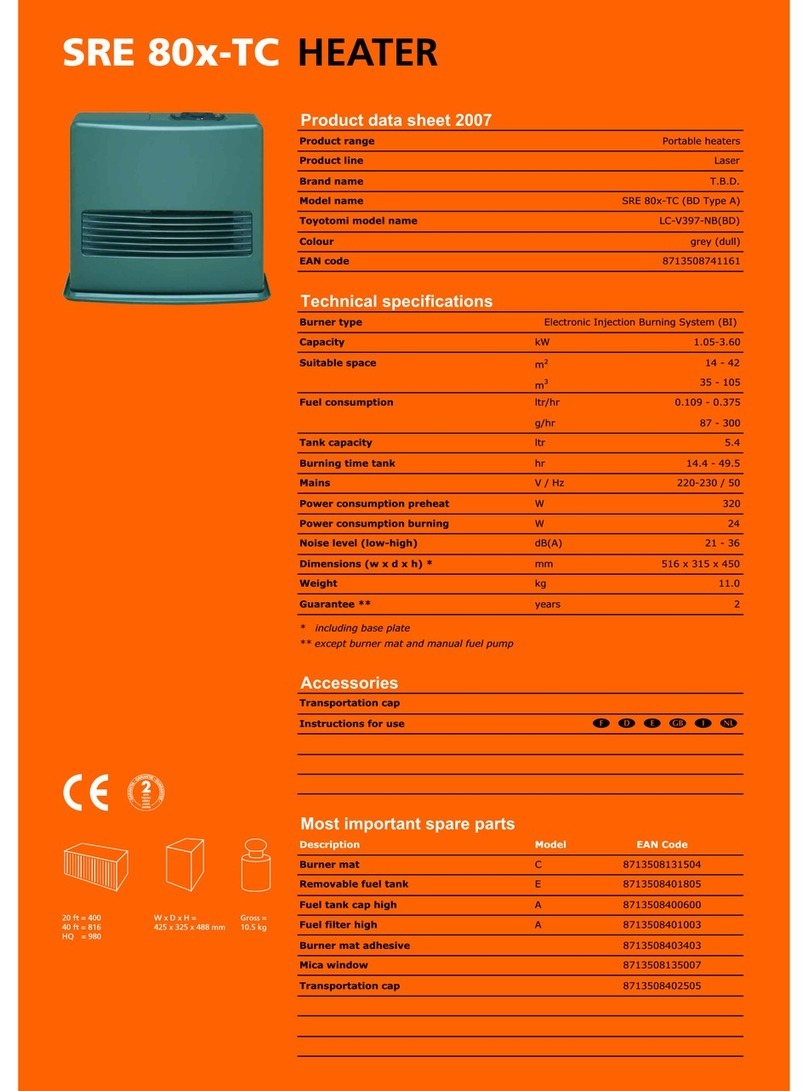
T.B.D.
T.B.D. HEATOR SRE 804 TC - datasheet
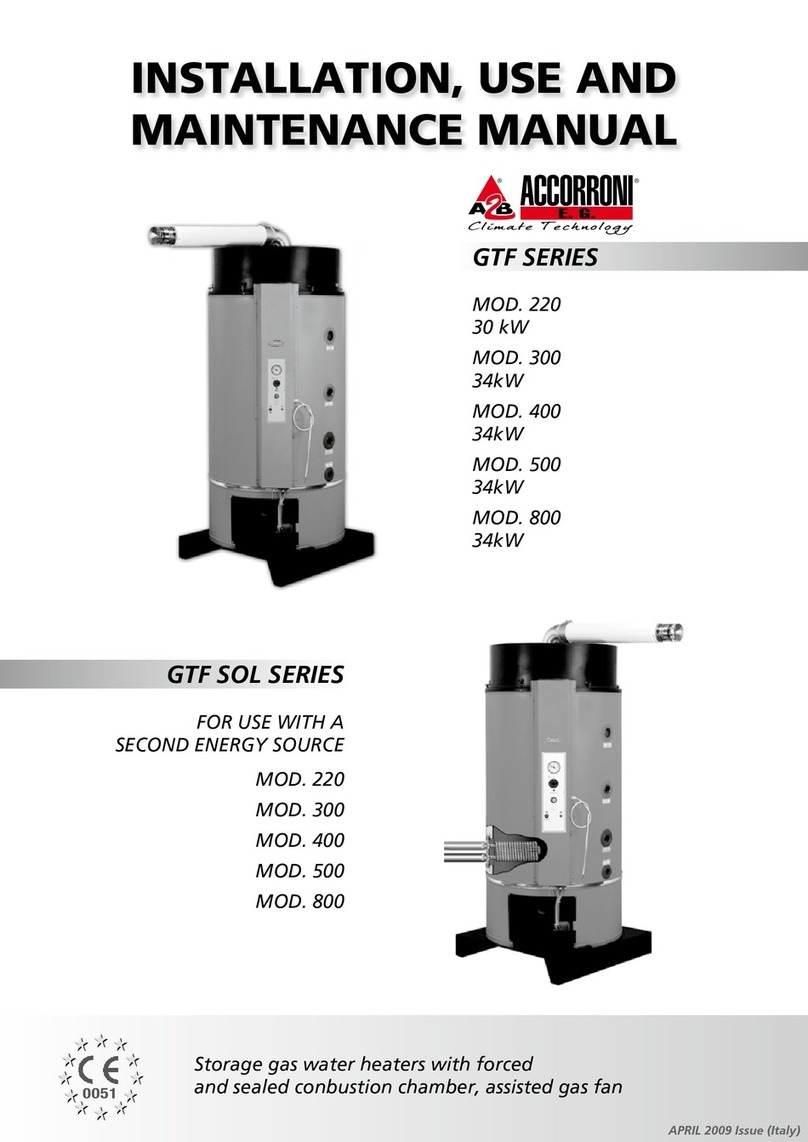
Accorroni
Accorroni GTF Series Installation, use and maintenance manual
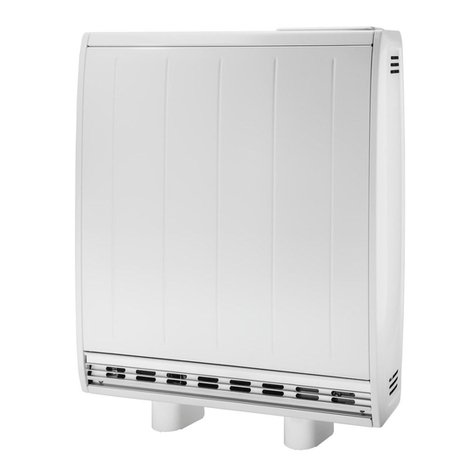
Dimplex
Dimplex QM050 installation instructions
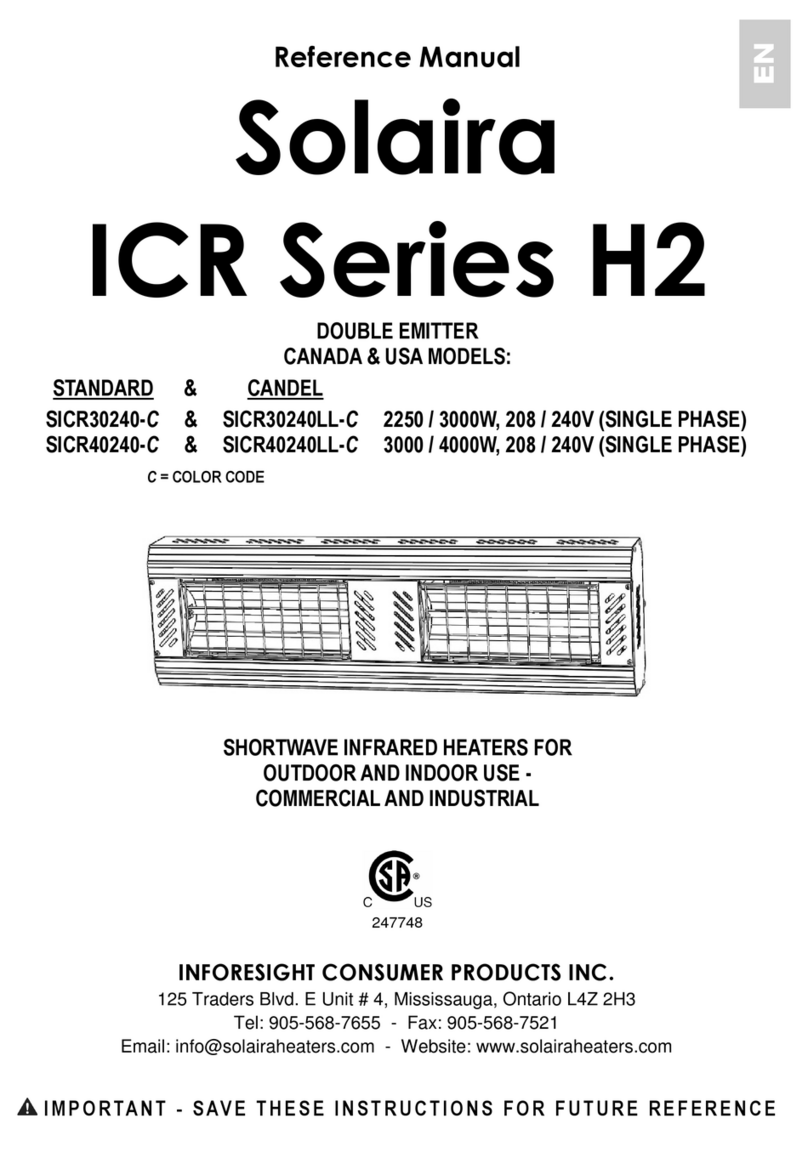
Solaira
Solaira ICR Series Reference manual
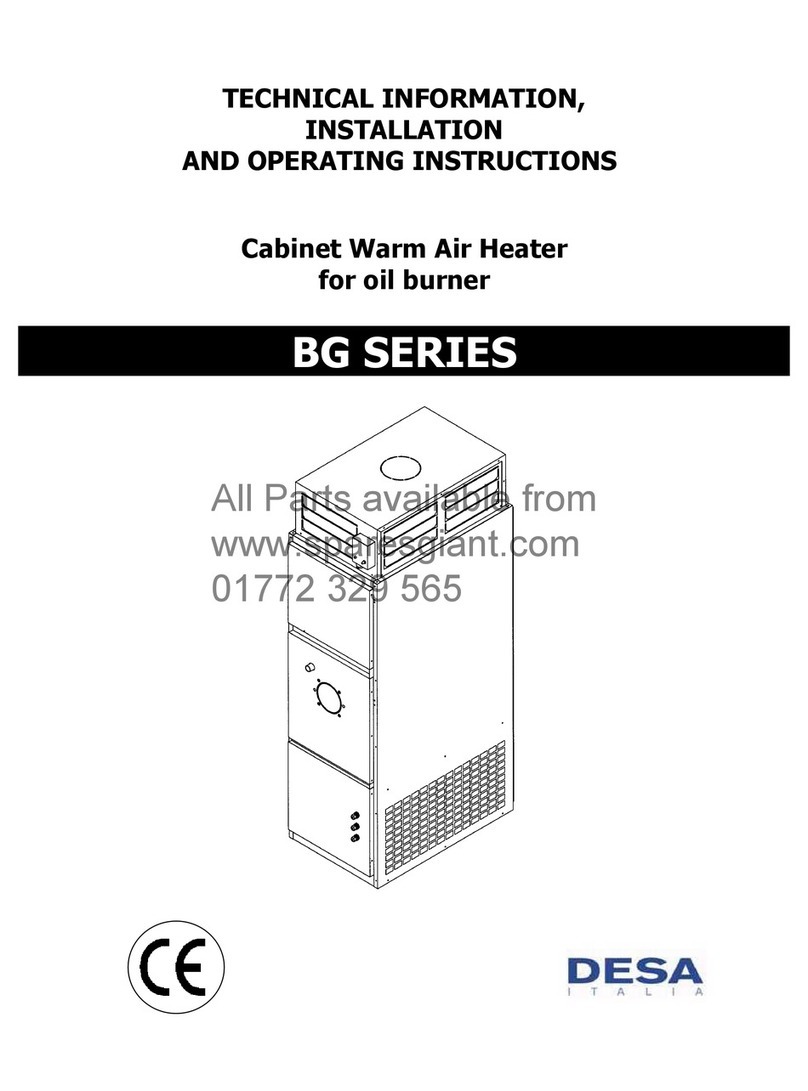
Desa
Desa BG SERIES operating instructions

Elnur
Elnur INTERTIARX4P Installation instructions and user guide



